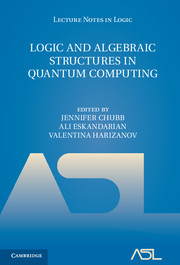Book contents
- Frontmatter
- Contents
- Preface
- Introduction
- 1 A (very) brief tour of quantum mechanics, computation, and category theory
- 2 Could logic be empirical? The Putnam-Kripke debate
- 3 The essence of quantum theory for computers
- 4 Fiber products of measures and quantum foundations
- 5 Operational theories and categorical quantum mechanics
- 6 Relating operator spaces via adjunctions
- 7 Topos-based logic for quantum systems and bi-Heyting algebras
- 8 The logic of quantum mechanics – Take II
- 9 Reasoning about meaning in natural language with compact closed categories and Frobenius algebras
- 10 Knot logic and topological quantum computing with Majorana fermions
- Index
- References
6 - Relating operator spaces via adjunctions
Published online by Cambridge University Press: 05 June 2016
- Frontmatter
- Contents
- Preface
- Introduction
- 1 A (very) brief tour of quantum mechanics, computation, and category theory
- 2 Could logic be empirical? The Putnam-Kripke debate
- 3 The essence of quantum theory for computers
- 4 Fiber products of measures and quantum foundations
- 5 Operational theories and categorical quantum mechanics
- 6 Relating operator spaces via adjunctions
- 7 Topos-based logic for quantum systems and bi-Heyting algebras
- 8 The logic of quantum mechanics – Take II
- 9 Reasoning about meaning in natural language with compact closed categories and Frobenius algebras
- 10 Knot logic and topological quantum computing with Majorana fermions
- Index
- References
Summary
Abstract. This chapter uses categorical techniques to describe relations between various sets of operators on a Hilbert space, such as self-adjoint, positive, density, effect and projection operators. These relations, including various Hilbert-Schmidt isomorphisms of the formtr(A−), are expressed in terms of dual adjunctions, and maps between them. Of particular interest is the connection with quantum structures, via a dual adjunction between convex sets and effect modules. The approach systematically uses categories of modules, via their description as Eilenberg-Moore algebras of a monad.
Introduction. There is a recent exciting line of work connecting research in the semantics of programming languages and logic, and research in the foundations of quantum physics, including quantum computation and logic, see [9] for an overview. This paper fits in that line of work. It concentrates on operators (on Hilbert spaces) and organises and relates these operators according to their algebraic structure. This is to a large extent not more than a systematic presentation of known results and connections in the (modern) language of category theory. However, the approach leads to clarifying results, like Theorem 14 that relates density operators and effects via a dual adjunction between convex sets and effect modules (extending earlier work [25]). It is in line with many other dual adjunctions and dualities that are relevant in programming logics [31, 1, 30]. Indeed, via this dual adjunction we can put the work [11] on quantum weakest preconditions in perspective (see especially Remark 15).
The article begins by describing the familiar sets of operators (bounded, selfadjoint, positive) on a (finite-dimensional) Hilbert space in terms of functors to categories of modules. The dual adjunctions involved are made explicit, basically via dual operation V ⟼ V∗, see Section 2. Since the algebraic structure of these sets of operators is described in terms of modules over various semirings, namely over complex numbers C (for bounded operators), over real numbers R (for self-adjoint operators), and over non-negative real numbers R≥0 (for positive operators), it is useful to have a uniform description of such modules. It is provided in Section 3, via the notion of algebra of a monad (namely the multiset monad).
- Type
- Chapter
- Information
- Logic and Algebraic Structures in Quantum Computing , pp. 123 - 150Publisher: Cambridge University PressPrint publication year: 2016
References
- 2
- Cited by



